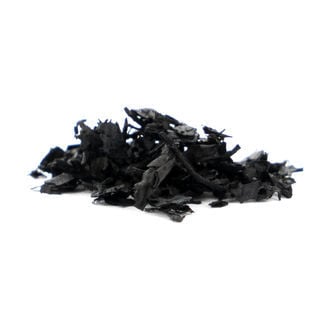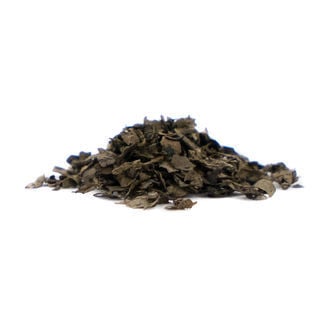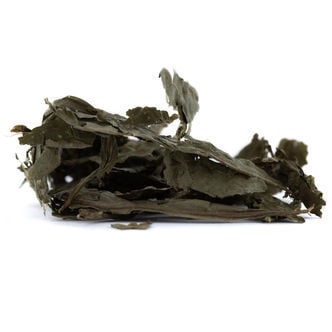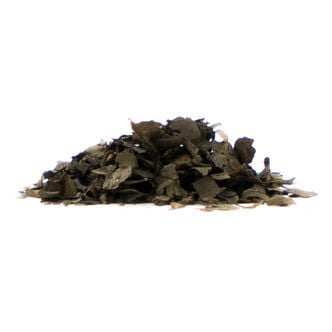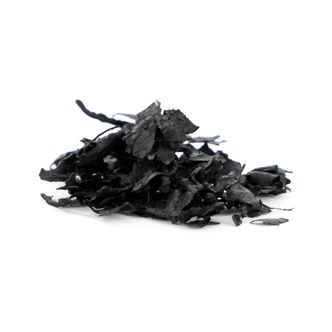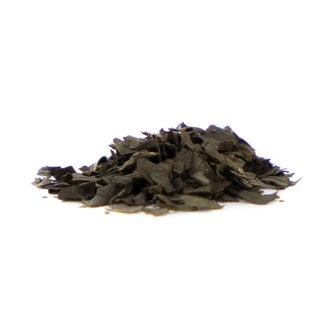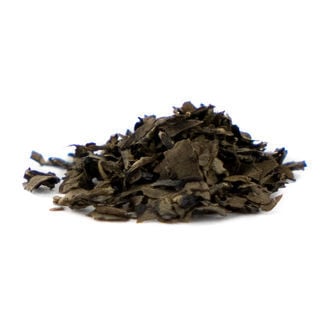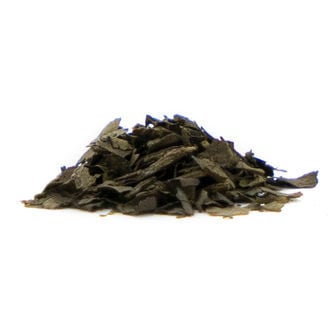Salvia divinorum
Here you can find all available varieties and strengths of Salvia divinorum, the Holy Sage. We have everything from pure dried Salvia leaves up through 10x, 20x, and as high as 80x Salvia extracts. It means the wise psychonaut can log some trips at low altitude before going for the full high flying experience.
Salvia Extract 20x
Half way between the pure herb and ‘ultimate strength’ 40x extract, this 20x Salvia extract will certainly blow away the cobwebs of your mind.
Salvia Extract 40x
For very experienced users and card-carrying Mexican shamans only! This is one of the the strongest Salvia extract we stock. You have been warned!
Salvia Dried Leaves
Salvia divinorum contains salvinorin A; one of the strongest psychedelics known to mankind today and should not be confused with a party drug. Under its influence you will perceive a completely different "reality" than the one you normally would. Salvia should be used in a comfortable and safe environment and only in company of a sober tripsitter.
Salvia Extract 5x
This 5x Salvia extract is a good strength to try as a first experience. Even though it’s the lowest strength extract we stock, the effects can still be a force to be reckoned with.
Salvia Extract 80x
Fasten your seatbelts! This is the brain's version of the Large Hadron Collider, this Salvia extract is only for the most experienced psychonauts. WARNING: Extremely strong, only for those who know what they're doing.
Salvia Extract 10x
Good for experienced trippers, the 10x extract will take you to the foothills of the mountain range that is the Salvia effect.
Salvia Extract 30x
Not recommended for the novice Salvia user, this 30x strength extract is guaranteed to catapult you into psi-berspace.
Salvia Extract 15x
With Salvia strengths ranging from straight herb to 80x extracts, this 15x is a good mid-range product for experienced trippers.
Information about Salvia divinorum
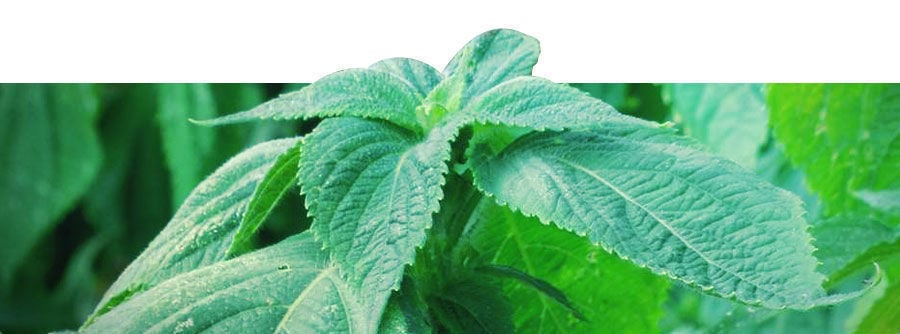
What is Salvia divinorum?
As one of the most powerful psychoactive plants available on the market today, Salvia divinorum boasts potent naturally occurring psychedelic properties. This is certainly not one for the faint of heart, but those looking for a deep and fulfilling experience will find it here. Some are quick to label psychedelics as more or less the same. However, salvia turns this stereotype on its head, affecting the opioid receptor as opposed to other molecular targets, and producing different effects as a result. But more on the effects shortly.
Roughly translated to “sage of the diviners”, Salvia divinorum is a plant native to Mexico with deep cultural connections and significant roots amongst the locals. It can provide a strong hallucinogenic high with just a minimal dose. While consideration and care should be given to all psychedelics, this could not be truer for Salvia divinorum.
Salvia divinorum is a psychoactive drug that can induce really intense psychedelic effects.
What other names is Salvia divinorum known by?
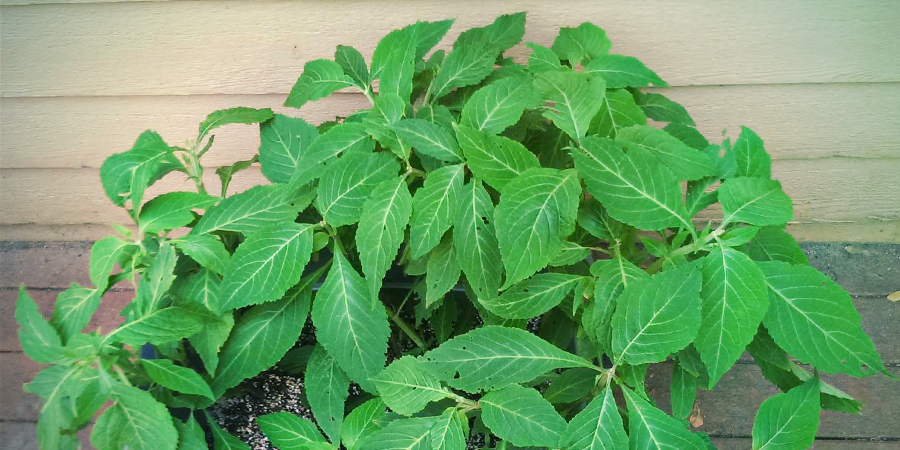
Below are just some of the names Salvia divinorum is known by. However, while you may hear these used, in the English speaking world at least, it is almost always known simply as salvia.
- Sage of the diviners
- Ska maría pastora
- Seer's sage
- Yerba de la pastora
- Sage of the seers
- Magic mint
- Lady salvia
- Purple sticky
- Shepherdess’s herb
- Sister salvia
The history of Salvia divinorum
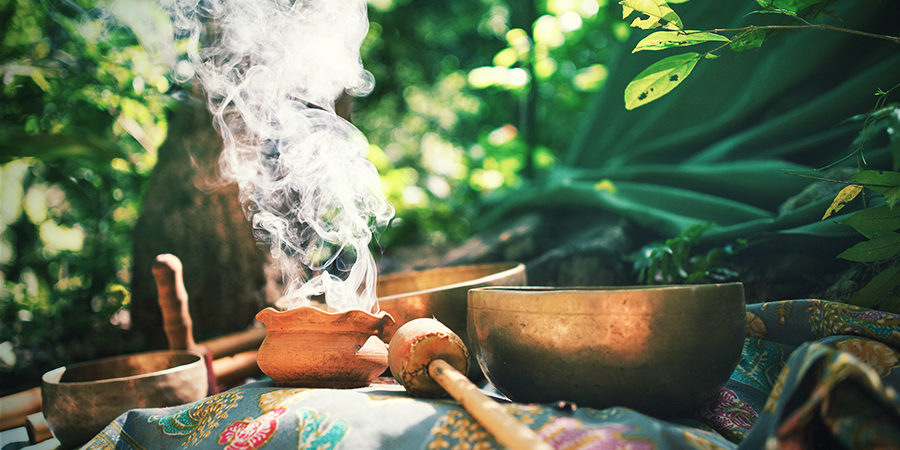
As mentioned, the story of this sacred psychedelic powerhouse has humble beginnings in Mexico. Originally cultivated in the isolated mountainous area of Sierra Mazateca in Oaxaca, Salvia divinorum was initially used by local shamans and Mazatec Indians as a means to experience hallucinogenic, profound, and religious visions. Salvia use is still popular to this very day in shamanic rituals, but how has it found its way to being a well-known psychedelic all over the world?
Salvia’s exposure can more or less be traced back to Jean Basset Johnson, who spent his short life studying the various plants and psychedelics he could get his hands on. This was the first introduction of the little-known salvia to the Western world. But it wasn’t until further research carried out by Daniel Siebert in the 90s that we would learn exactly what this plant is capable of.
While research into the effects and potency of salvia use continues, there’s no doubt that this plant has come a long way from its ceremonial roots that date back hundreds, if not thousands, of years.
How does Salvia divinorum work?
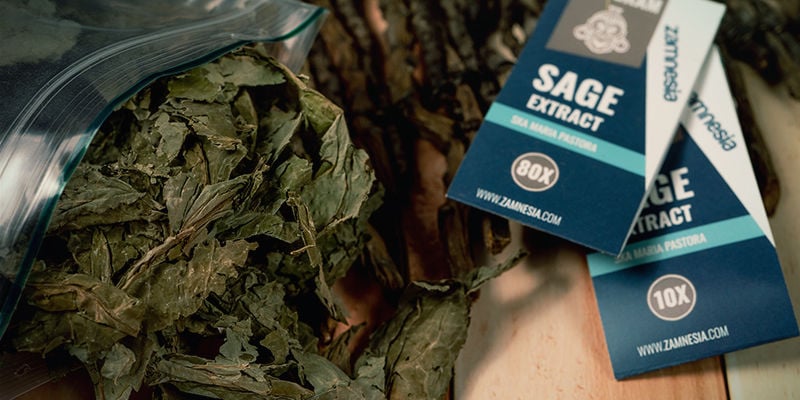
Salvia divinorum is a unique psychedelic. While most (mushrooms, LSD, DMT) bind primarily to serotonin receptors, salvia binds to the kappa opioid receptor (KOR). Where most psychedelics increase levels of serotonin, salvia reduces levels of dopamine. In doing so, it raises interesting questions about what causes a “psychedelic” experience. The active compound in salvia is salvinorin A. Interestingly, this is an opioid-like compound, but with distinctly non-opioid-like effects.
Relatively little research has been done into what happens to the brain during a salvia trip, but we know a few things. By binding to the KOR, the default mode network (DMN) is bypassed. This is common among many drugs, especially psychedelics. The role of the DMN is to communicate between different parts of the brain and create some sort of holistic experience. By reducing the DMN, the individual parts of the brain fire up and communicate directly with one another, instead of being filtered through a central system. Exactly how essential this is to tripping is up for debate. For a long time, many researchers have seen it as the cornerstone of the psychedelic experience. However, some disagree, as many drugs that do not induce a psychedelic experience still reduce the dominance of the DMN.
The effects of salvia have been categorised in their own unique scale. The Salvia Experiential Rating Scale rates the effects from least to most intense, with each letter of the word salvia corresponding to a different threshold of effects.
What are the effects of Salvia divinorum?
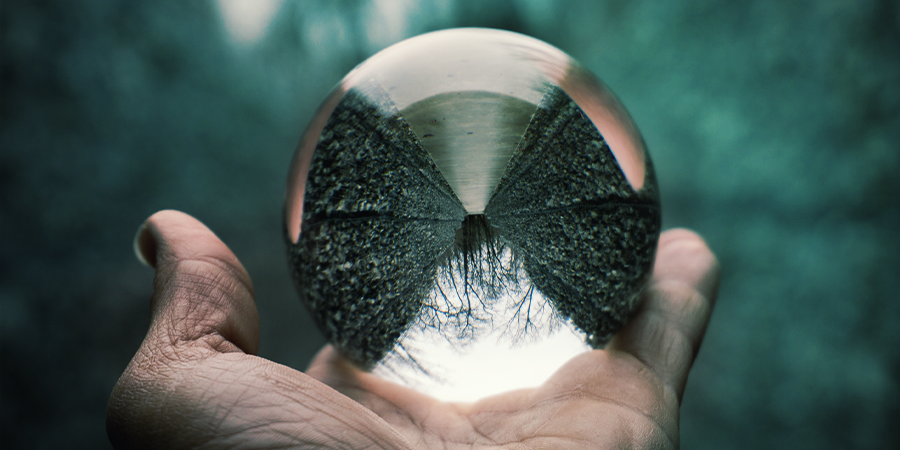
Salvia divinorum's active ingredient is salvinorin A, which is believed to be behind the potent effects this plant is known for. Salvinorin A is a strong dissociative hallucinogen that affects the kappa opioid receptor, the part of the brain that regulates perception.
Powerful even in the smallest dose, salvinorin A is undoubtedly not a psychedelic to use at parties or if you are just looking to chill out. Demonstrated by its history, salvia is mainly used for expanding the mind, causing you to potentially leave the physical world to one side. Whether you are experienced with psychedelics or new to them, salvia deserves to be treated with the utmost respect.
The effects of Salvia divinorum are categorised by the “Salvia Experiential Rating Scale”: (S)ubtle effects, (A)ltered perception, (L)ight visionary state, (V)ivid visionary state, (I)mmaterial existence, and (A)mnesic effects.
S — Subtle effects
This is the mildest high you can experience. These effects are barely noticeable and leave users feeling relaxed and contemplative. Some may even experience feelings of deep focus.
A — Altered perception
The second level offers a high similar to that of cannabis. Music may sound fuller or more complex to the user. Altered perception provides a change in thought pattern and other sensory details. You may believe that the space immediately around you feels different. This level can also potentially affect short-term memory.
L — Light visionary state
This is the initial hallucinogenic stage of taking salvia, where the salvinorin A gets to work binding with those kappa opioid receptors. The user can expect to experience light visions, both aural and visual. These are often in the form of pulsating lights or repeating geometric shapes and designs—all in a variety of different colours and tones. The user is still conscious of themselves and their surroundings, experiencing these visions as temporary imagery.
V — Vivid visionary state
The Vivid Visionary State follows the Light Visionary State. The user will still experience visual and aural hallucinations, but they will be fuller and longer-lasting than the previous level. With their eyes closed, some users claim to have visions and hallucinatory journeys to other dimensions and landscapes while in this state. It is important for users to sit back, relax, and let the trip fully take over at this level.
I — Immaterial existence
Level five is Immaterial Existence. This is the part of the trip where hallucinations become even stronger, and the user’s anchoring in reality begins to shift. While users are still conscious of themselves, the immediate world around them will be strongly influenced by the trip. Many users say they have profound in-depth conversations with themselves or some “divine beings”. Immaterial Existence is often seen as the goal of the salvia experience.
A — Amnesic effects
While Immaterial Existence is seen as the “peak” of the trip, there is one final stage to the Saliva Experiential Rating Scale. This is Amnesic Effects—where the user will not be aware that they're tripping, or, potentially, even who they are. Some will be able to sit silently throughout the trip, whereas others may make noise and move around. Those that reach this level will often not remember any of the trip. Psychonauts looking to get the maximum benefit from their experience should potentially consider stopping at the previous level.
While there are no long-term or significant side effects of a salvia trip, most people will nominate a chosen friend to be a designated trip sitter. This is a party that will remain sober during the trip and make sure nothing untoward happens to you. This includes making sure the environment remains relaxed and safe, with no outside influences interfering with the trip.
When taking salvia, make sure the TV is off, as this can impede the trip. Although, you can put on some quiet music if you prefer. Tripping in a private, quiet, and safe environment is paramount to a pleasant experience.
What is the best way to take Salvia divinorum?
Now that the effects have been covered, we can take a look at the many different ways you can experience the effects of salvia and its active ingredient salvinorin A. There is no right or wrong way to use salvia, so you may discover some other ways to take it that suit you.
SALVIA QUID
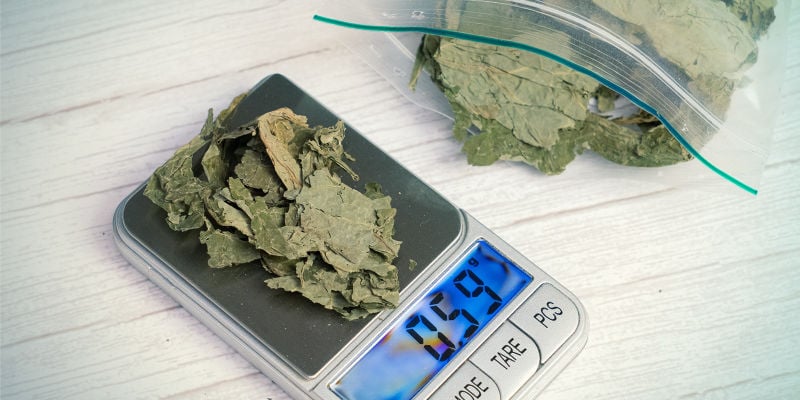
A salvia quid is essentially a rolled ball or cylinder of leaves. These are then slowly chewed, allowing the salvia to be absorbed via the oral mucosa and gums. After a period of around half an hour, the effects will begin. Many users keep a bowl or towel close by to spit out the used quids. Just make sure you don’t spill any juice as it can stain clothes, carpets, and any other cloth.
Making a salvia quid is a reasonably straightforward process. While you can use either moist, fresh leaves or dried salvia leaves, it is worth noting that dry leaves offer a sweeter flavour and are overall less bitter.
Once you have your leaves, you can look to measure out 3–8 grams. If you do not have a scale available, around 8–20 large, whole dried leaves will do the trick. They can then be soaked in cold water for several minutes. After this time, remove the leaves and squeeze them until the water is drained. The resulting damp leaves can then be rolled into cylinders or balled up, depending on your preference.
This is the tried and tested method of making a salvia quid. However, some prefer to simply ball up the dried leaves and have them as they are. But this is purely down to preference as the taste and texture would be completely different from the normal quid. Some users even prefer to flavour their quids with sugar, honey, or syrup. It’s entirely up to you.
METHODS OF MAZATEC INDIANS
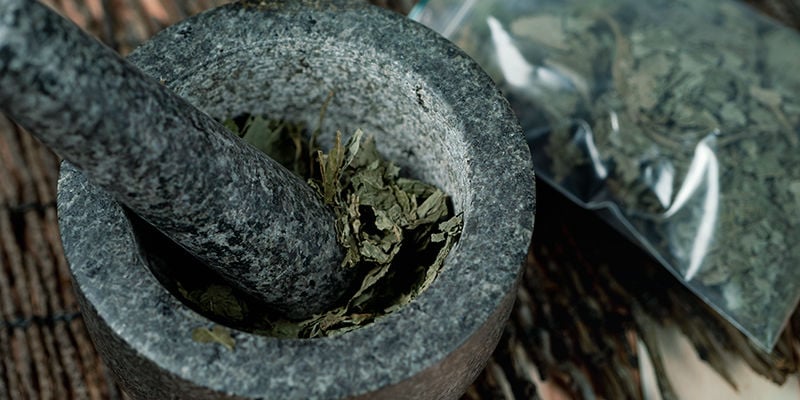
Several methods are derived from traditional Mazatec Indian ceremonies. In one particular method, the leaves are pulped and then infused into a liquid. Unlike the quid, which has an almost immediate but shorter effect, this method offers a more prolonged experience that, while perhaps not suitable for first-timers, is one of the most traditional preparations.
-
Drink
This method is achieved by grinding and pulping a large amount of Salvia divinorum leaves. This pulp is then filtered into a drink. Many who have tried this method state that the liquid has a bad flavour. Those looking for a more pleasant method could add flavour-enhancers to try and counter the bitter taste of the salvia leaves.
Although the effect is longer-lasting, salvinorin A doesn’t absorb as well into the bloodstream via the stomach. However, as this method is steeped in cultural importance amongst the Mazatec people, it is not as popular among those outside of the culture. Those looking to try salvia from a traditional standpoint should do their best to respect these historic practices.
-
Eat
The second method is simply just eating the salvia leaves. The user essentially pulps the leaves in their mouth before swallowing. As mentioned, the bitter taste of the dried salvia leaves is an acquired one, not to mention the fact that the texture may make it difficult to swallow. This method is also less potent than making a quid, as the digestive system will limit the potency of the salvinorin A. Much like the previous method, this is a traditional way of ingesting salvia that may only be suitable for experienced salvia users.
Those are just a couple of ways that you can take salvia. There are certainly other methods available out there that offer extra potency and are easy to achieve. As mentioned, there are no set rules. You are only limited by your imagination when it comes to finding a method that suits you.
How long do the effects of Salvia divinorum last?
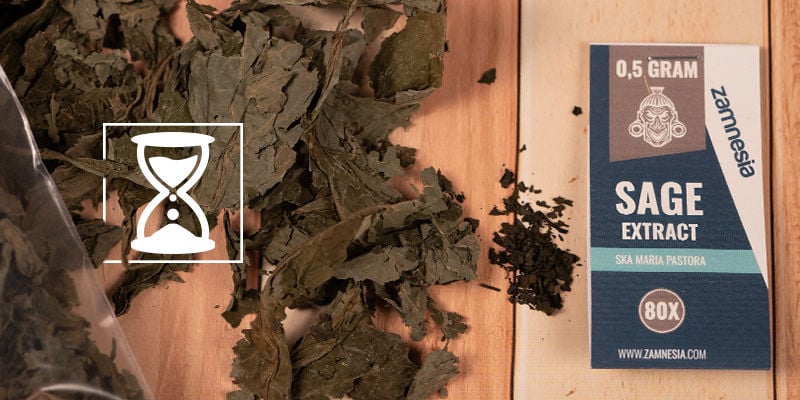
How you ingest Salvia divinorum will dictate roughly how long the effects last.
-
Inhalation
This is perhaps the most common method of intake outside of traditional practice. When inhaled, the effects of salvia will appear almost immediately, peaking at 1 to 5 minutes. After this, effects will taper off. Users will return to sobriety within about 15 to 20 minutes, with no lasting effects.
-
Chewing
This is how salvia is traditionally ingested by Mazatec shamans. When chewed, the salvinorin A is absorbed through the oral mucosa (blood vessels in the mouth). Usually, the effects will last for between 1 and 2 hours, and are much milder than when inhaled.
-
Drinking
Salvia leaves can be mashed into a sort of juice. This is then drunk and digested. How long this takes to cause effects depends on the individual and how much you have eaten, but between 10 and 30 minutes is common. Again, the effects should not last more than a few hours. Much of the salvinorin A will be deactivated in the stomach prior to entering the bloodstream. As such, this method of ingestion is comparatively mild.
-
Sublingual
Similar in duration to drinking, sublingual tinctures can produce much stronger effects. The salvinorin A is extracted in alcohol, and this solution is then dropped under the tongue. The intensity of the trip will be determined by the strength of the extract. Due to the length and potential strength of such a trip, ensure you are as well-prepared as possible before embarking upon this route. Also, make sure you know how strong the extract actually is!
Which types of salvia are available?
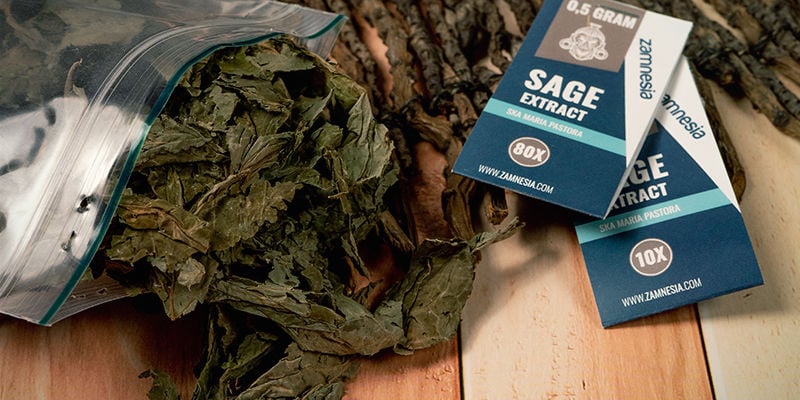
There are two types of salvia available: dried leaves and extracts. Both are derived from the plant and both are amenable to most ingestion methods. While they ultimately offer the same effects, there are some key features that differentiate them.
DRIED SALVIA LEAVES
As the purest way you can buy salvia, these are the dried leaves from this mysterious plant from the mint family. From there, you can look to pulp them, make a quid, or simply eat them—the choice is entirely up to you. Either way, you can experience the strong effects of salvinorin A influencing the opioid receptor.
SALVIA EXTRACT
Extracts are another way to ingest salvia, ranging from 5x for newcomers all the way to 80x for those experienced with psychedelics. Make no mistake, the lowest strength is still sure to offer immense potency and very noticeable effects. The extract is taken from the plant, dissolved, and then distributed back onto the leaves. For example, a 5x extract would have had four units extracted from the leaf, which would then be redistributed over one unit of the leaf. This is the case for all the levels of extract that you’ll see at Zamnesia.
Whichever type you decide upon, it is important to treat them with the same amount of care, regardless of strength. Here, the salvinorin A will be highly concentrated, meaning it’s much easier to experience strong effects with a small dose than with the dried leaves.
How to prepare for a Salvia divinorum trip

There are several things you can do to prepare for your Salvia divinorum trip. Again, it is important to remember that salvia is not a party drug, nor is it a chill drug to relax with, like cannabis. While the effects do not last for a long time, they can be incredibly profound and powerful, so prepare yourself and set some time aside to get the most from your trip. Here are a few suggestions…
SETTING
Make sure your environment is ready for the trip. This means making the area comfortable, making sure the TV is turned off, and that your attention is on the task at hand. Some relaxing music can be played in the background if you prefer.
TRIP SITTER
As mentioned, having a sober trip sitter around while you’re tripping is often advisable. They can keep an eye on you and help you keep your wits about you during the experience. A number of users experience extreme and sometimes terrifying visions and hallucinations. Having that friend nearby will often make them feel better as the high wears off. A good trip sitter will not interfere with the trip itself, instead playing more of a background role, making sure the environment stays safe and the person tripping is looked after.
MIND(SET)
Arguably the most crucial area to prepare is your own mindset. Using salvia involves a certain degree of maturity, and you want to be in a positive frame of mind going into the experience. Being tense or dealing with negative emotions can make your trip go south, which can in turn discourage you from using salvia in the future. So clear your mind before you set sail.
Physically, there are also things you can do. Cleaning all of the areas inside your mouth will make your quid a little more potent. So brush up, use that mouthwash, and you’ll be ready for what salvia has to offer.
Why is salvia — sometimes — such a terrifying trip?
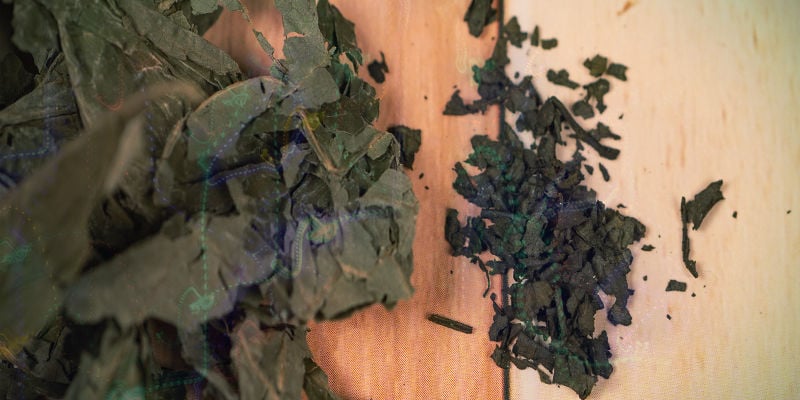
Salvia is famous—or infamous—for producing an utterly terrifying trip. There are a number of known reasons for this, and undoubtedly many unknown ones. Below are some chemical reasons that may explain the propensity for uncomfortable trips.
There is perhaps another reason, though. As it is still legal across much of the world, many assume it is less strong than illegal drugs. As such, it may be abused more than other hallucinogens. You can’t buy a hit of 100x strength DMT in a shop and smoke it as a joke—you can with salvia. So, before writing it off, treat it with the respect it deserves and see what it has to show you.
1. Salvia as an atypical psychedelic
As previously mentioned, Salvia divinorum is not a typical psychedelic. Not only does it not bind to serotonin receptors, but its effects are not typical either. It is also atypical as an opioid. Whereas most opioids are antagonists—they block receptors—salvinorin A is an agonist, exciting receptors.
2. Salvia and synesthesia
Salvia can cause massive synesthesia—merging of the senses. While all psychedelics are capable of this to a degree, it is particularly pronounced under the effects of Salvia divinorum. Users report being able to feel sight, hear feelings, and see sounds. This total merging of sensory input contributes to the extreme discomfort people report when on salvia.
3. Salvia binds to a single receptor
Most drugs will bind to multiple receptor sites in the brain, each contributing to the overall effects. Salvinorin A, however, binds exclusively to the KOR. This specificity is likely to contribute to its incredibly powerful and, potentially, overwhelming effects.
4. Euphoria vs dysphoria
Whereas other psychedelics produce euphoria, salvia produces dysphoria—mostly physical. So, the biochemical irregularities translate into irregularities in the experience too. Of course, not everyone would describe their other psychedelic experiences as “euphoric”. In this sense, euphoria specifies a connection between you and your body/physicality. Salvia is dysphoric in that people often feel separate from their physicality. This sense of separation can be very scary, as your whole reality shifts.
Moreover, salvia hits instantly. It shares similarities with DMT in that sense. But, this can make it scarier than most highs. Going from sober to another universe in a heartbeat can be a disconcerting experience, to say the least.
How long does salvia stay in your system?
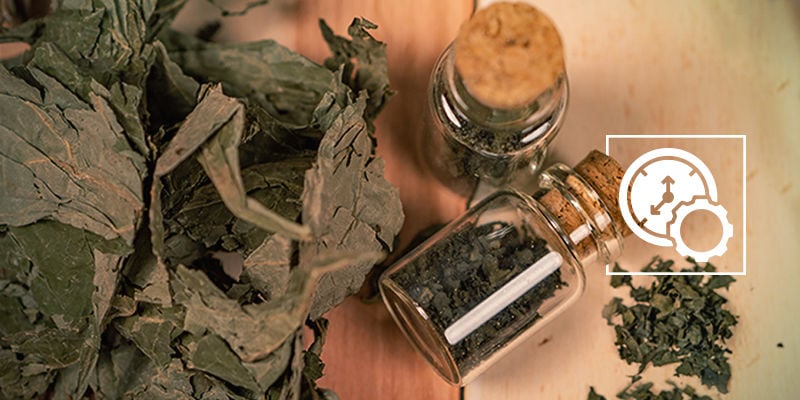
Like all drugs, individual factors will determine how long salvia remains in the body, such as dose and the user’s weight and metabolism. However, compared to most drugs, it is thought to have a very short half-life. This is why the effects wear off so rapidly, as it becomes broken down swiftly in the body. In the blood, it is thought to have a half-life of only 60 minutes. This means that every hour, the levels of salvia in the blood will reduce by half. Though there’s no exact answer, salvia appears to remain in the blood for a period of up to 12 hours.
This is extremely short. As such, it can be very difficult to detect. In fact, using common drug tests, it is near-impossible to detect. Advanced tests can detect salvinorin A, and vary depending on the type of specimen:
- Liquid chromatography-mass spectrometry (urine and blood)
- Gas chromatography-mass spectrometry (blood, urine, saliva)
- Excessive performance liquid chromatography-atmospheric strain chemical ionisation (blood and urine)
Note: Unlike many drugs, salvia does not seem to be detectable in hair follicles.
Can you overdose on salvia?
This cannot be properly answered. Technically, no toxicity level for salvia has been assessed, and therefore no overdose level is known. This does not mean that you cannot overdose on salvia. Even if a lethal overdose is unlikely, taking too much is extremely easy. In fact, there are few drugs easier to take too much of, and with such powerful effects. Just take a look on YouTube. So, when taking salvia, start small—you’ll be surprised just how potent it is!
Can you grow Salvia divinorum?
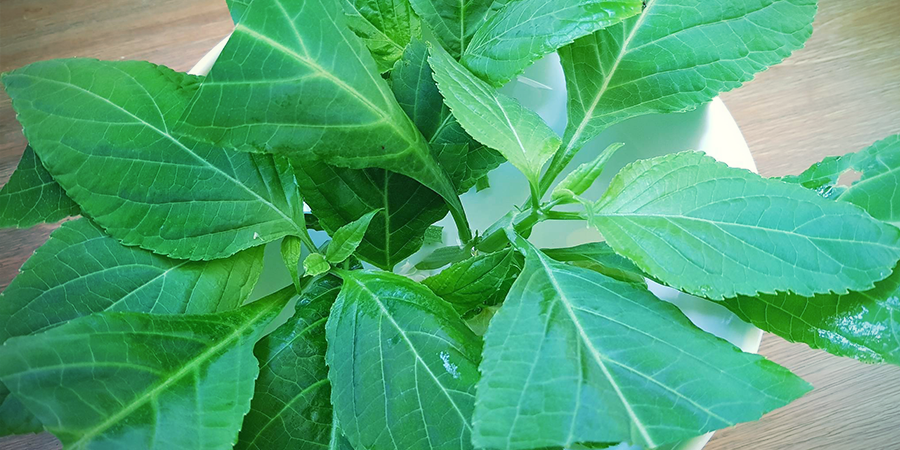
Absolutely. Growing your own “magic mint” plant could surely be the next step in your enjoyment of this psychedelic. Fortunately, you don’t need to visit the furthest reaches of Mexico to get your plants going. Because Salvia divinorum doesn’t produce an abundance of viable seeds, the plant is usually grown from cuttings instead. This is a more reliable way to grow the plant.
Salvia is a semi-tropical plant and requires a similar setting to flourish. An ideal temperature between 15–27°C with a humidity level of 50% or more will allow her to thrive. Salvia divinorum can grow very tall, with some plants reaching 2.5m feet tall. The plants themselves can be brittle with weak stems, so some support or staking will help her as she grows. Keep an eye on her, water when dry, and you’ll be able to take your own cuttings from her before you know it.
As Salvia divinorum only produces seeds on rare occasions, it's grown best from a cutting.
When to harvest Salvia divinorum
Salvia is a fragile plant and you must be careful when harvesting in case you kill the plant. However, there is a very simple and risk-free way to harvest salvia leaves, but it requires patience. You can just wait for them to die and fall off the plant. By doing this, you pose no risk to it. That being said, if you don’t have many plants, this can take a long time and you may not get a satisfactory amount.
If you intend to harvest from a living plant, wait until it is at least a year old. Harvest an equal amount from all the plants you have, rather than taking the whole harvest from a single plant. This way, no individual plant bears the brunt of the shock, and you mitigate the risks to their health.
How and where can you get Salvia divinorum?
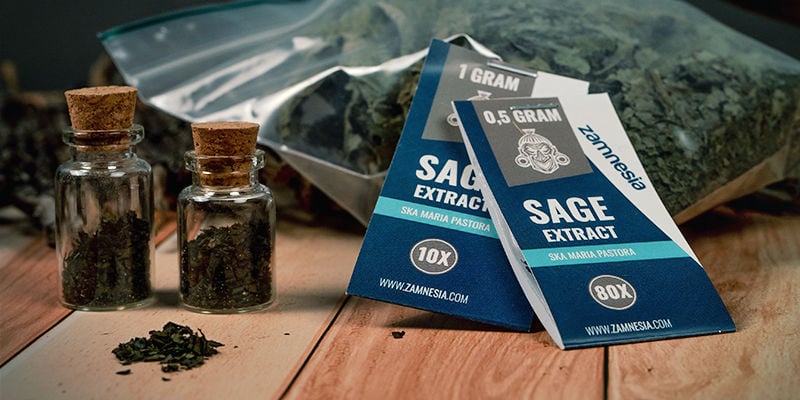
Luckily, there’s a much easier way to get your hands on Salvia divinorum than growing it. The dried leaves and extracts from this plant are available right now to order from the Zamnesia store. This way, you can go on your consciousness-expanding journey whenever you see fit. Salvia use has been a part of the culture of Mazatec Indians for much longer than Westerners have experienced it, so remember to treat the experience with respect and appreciation.
Salvia divinorum: Questions & Answers
- 🌿 What is Salvia divinorum?
- Salvia divinorum is a psychoactive drug that can induce really intense psychedelic effects. It belongs to the sage (Salvia) genus.
- 🧠 What are the effects of Salvia divinorum?
- The effects of Salvia divinorum are categorised by the “Salvia Experiential Rating Scale”, which rates the experience on a spectrum from least to most intense, corresponding to each letter of the word “Salvia”. They increase as follows:
- (S)ubtle effects
- (A)ltered perception
- (L)ight visionary state
- (V)ivid visionary state
- (I)mmaterial existence
- (A)mnesic effects
- 🤔 Is Salvia divinorum the same as sage/regular salvia?
- The Salvia genus is quite large, and Salvia divinorum is not the same as culinary sage. Of the many Salvia species, only Salvia divinorum contains the active compound salvinorin A, which is believed to be responsible for inducing psychoactive effects.
- 🌳 How to grow Salvia divinorum?
- As Salvia divinorum only produces seeds on rare occasions, it's grown best from a cutting. Salvia should not be exposed to temperatures lower than 10°C at any time. The ideal temperature for the plant is between 15–27°C. It is happiest in an environment with a relative humidity of 50% or more.













 United States
United States
